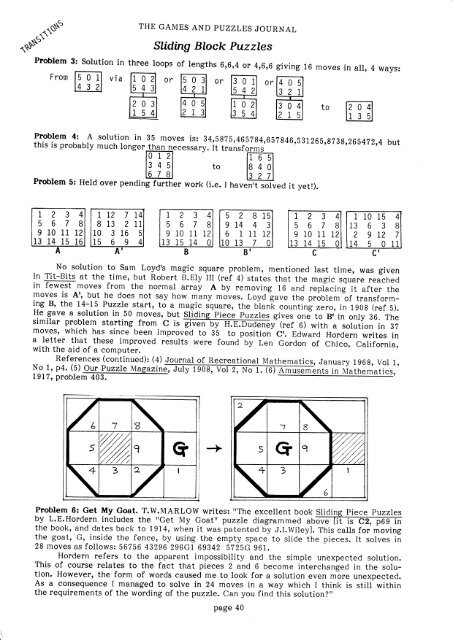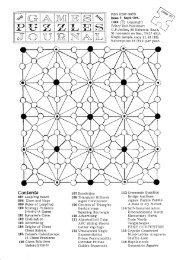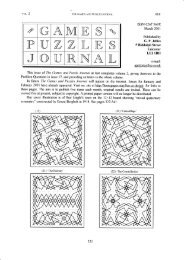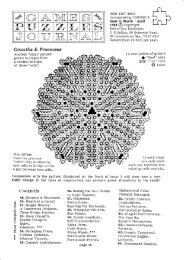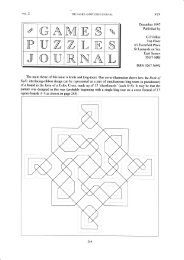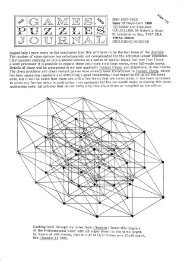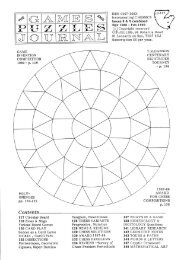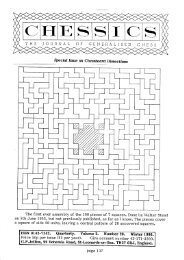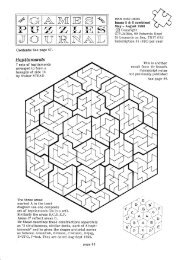The Games and Puzzles Journal, #3 - Mayhematics
The Games and Puzzles Journal, #3 - Mayhematics
The Games and Puzzles Journal, #3 - Mayhematics
- No tags were found...
You also want an ePaper? Increase the reach of your titles
YUMPU automatically turns print PDFs into web optimized ePapers that Google loves.
.N\5<br />
n+"'<br />
ns$'\o'<br />
Problem<br />
From<br />
Solution<br />
a<br />
V1<br />
ln<br />
a<br />
THE GAMES AND PUZZLES JOURNAL<br />
Sliding Block <strong>Puzzles</strong><br />
three loops of lengths 6,6,4 or<br />
or<br />
0r<br />
416,6<br />
0r<br />
giving 1O<br />
l*3<br />
13 1l<br />
lro<br />
12 1 5l<br />
moves in all, 4 ways:<br />
to<br />
Problem 4z A<br />
this is probably<br />
solution in<br />
much longer<br />
35 moves is: 34,58 5,4657 84,65846,531265,g3g ,265472r4 but<br />
than necessary. It transforms<br />
Problem 5: Held over pending further work (i.e. I haven't solved it yet!).<br />
iTr3lE;:vil-:iirf,|,s28rsln2341<br />
l5 6 7 sll8t3 zrrl ls 6 7 sllgr+ q sl ls 6 t al<br />
le10111zll10 316 5l lsrorrrzllo rrrrzl lgrorrrzl<br />
113 14 15 161 lrs 0= g +l lrs rs r+ ol [o rs z ol lrr r+ rs ol<br />
A A, B ----Br- T<br />
to<br />
No solution to Sam Loyd's magic square problem, mentioned last time, was given<br />
in Tit-Bits at the time, but Robert B.Ely III (ref 4) states that the magic square ,.i.n.o<br />
in ffimoves from the normal array A by removing 16 <strong>and</strong> replacing it after the<br />
moves is Ar, but he d-oes not say how many moves. Loyd gave tne prouem of transforming<br />
B, the 14-15 Puzzle start, to a magic square, the biani countini zero, in 190g (ref<br />
He gave s).<br />
a solution in 50 moves, but Sliding.-Piege <strong>Puzzles</strong> gives onJ to B' in only 36. <strong>The</strong><br />
similarproblemstartingfromCisffiy(rerol-*itnasolutionin3<br />
moves' which has since been improved to 3-5 to position Ct. Edward Hordern<br />
a letter<br />
writes in<br />
that these improved results were found by Len Gordon of chico, California,<br />
with the aid of a computer.<br />
References (continued): (4) <strong>Journal</strong> of Recreational<br />
No t, p4. (5) Our Puzzle Magazin<br />
LgL7, problem 40L<br />
1 10 15 4<br />
13 6 3 B<br />
2 912 7<br />
L4 5 0 11<br />
c'<br />
Mathematics, January 1908, Vol 1,<br />
ati cs,<br />
-7<br />
5 9<br />
E<br />
1<br />
5<br />
G g %<br />
3 I<br />
3 I<br />
Problem 6: Get My Goat. T.W.MARLOW writes:r<strong>The</strong> excellent book Slidins piece puzzles<br />
byL.E.Hordernincludesthe'lGetMyGoat''puzzIediagrammeoauffi<br />
the book, <strong>and</strong> dates back to 1914, when it was patented by J.I.Wileyl. This calls formoving<br />
the goat' G, inside the fence, by using the empty space to slide the pieces. It solves in<br />
28 moves as follows: 56756 43296 296c1 69542 b2bc 961.<br />
Hordern refers to the apparent impossibility <strong>and</strong> the simple unexpected solution.<br />
This of course relates to the fact that pieces 2 <strong>and</strong> 6 become intercnanged in the solution.<br />
However, the form of words caused me to look for a solution even more unexpected.<br />
As a consequence I managed to solve in 24 moves in a way which I think is still within<br />
the requirements of the wording of the puzzle. Can you find this solution"<br />
page 40


